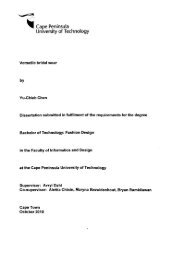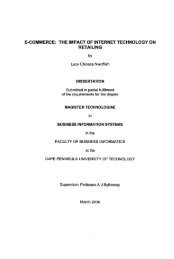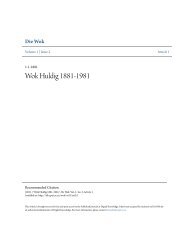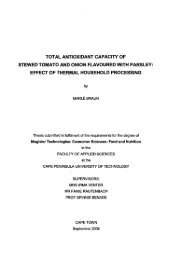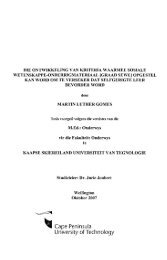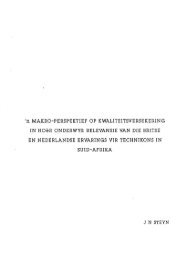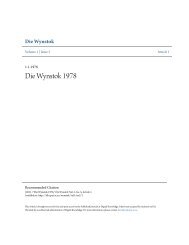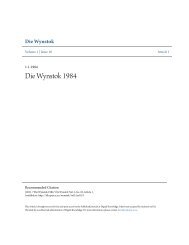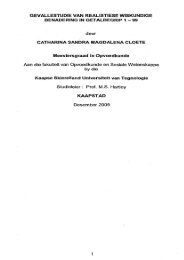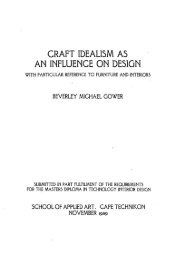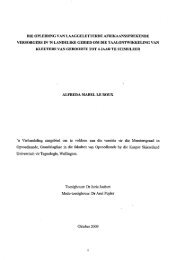the effect of the particle size distribution on non-newtonian turbulent ...
the effect of the particle size distribution on non-newtonian turbulent ...
the effect of the particle size distribution on non-newtonian turbulent ...
Create successful ePaper yourself
Turn your PDF publications into a flip-book with our unique Google optimized e-Paper software.
Chapter 1 Introducti<strong>on</strong> Page lA<br />
flow, which in turn affects <str<strong>on</strong>g>the</str<strong>on</strong>g> viscous sub-layer.<br />
However, even with findings such as <str<strong>on</strong>g>the</str<strong>on</strong>g>se, most <str<strong>on</strong>g>of</str<strong>on</strong>g> <str<strong>on</strong>g>the</str<strong>on</strong>g> <str<strong>on</strong>g>the</str<strong>on</strong>g>oretical models which have been<br />
proposed to predict <strong>turbulent</strong> flow behaviour have not taken into account <str<strong>on</strong>g>the</str<strong>on</strong>g> <str<strong>on</strong>g>size</str<strong>on</strong>g> <str<strong>on</strong>g>of</str<strong>on</strong>g> <str<strong>on</strong>g>the</str<strong>on</strong>g><br />
<str<strong>on</strong>g>particle</str<strong>on</strong>g>s inherent in <str<strong>on</strong>g>the</str<strong>on</strong>g> fluid. In fact Mun (1988) states that <str<strong>on</strong>g>particle</str<strong>on</strong>g> <str<strong>on</strong>g>size</str<strong>on</strong>g> is <str<strong>on</strong>g>the</str<strong>on</strong>g> most<br />
frequently overlooked piece <str<strong>on</strong>g>of</str<strong>on</strong>g> data in published literature data. Only as recently as 1994<br />
was a new model been proposed by Slatter (1994) to account for not <strong>on</strong>ly <str<strong>on</strong>g>the</str<strong>on</strong>g> rheology <str<strong>on</strong>g>of</str<strong>on</strong>g><str<strong>on</strong>g>the</str<strong>on</strong>g><br />
.<br />
slurry but also <str<strong>on</strong>g>the</str<strong>on</strong>g> representative <str<strong>on</strong>g>particle</str<strong>on</strong>g> <str<strong>on</strong>g>size</str<strong>on</strong>g> <str<strong>on</strong>g>of</str<strong>on</strong>g> <str<strong>on</strong>g>the</str<strong>on</strong>g> solids.<br />
1.2 OBJECTIVE<br />
The aim <str<strong>on</strong>g>of</str<strong>on</strong>g> this study is to model <strong>turbulent</strong> flow using Slatter's model as well as o<str<strong>on</strong>g>the</str<strong>on</strong>g>r<br />
models already well established in <str<strong>on</strong>g>the</str<strong>on</strong>g> literature, to determine <str<strong>on</strong>g>the</str<strong>on</strong>g> <str<strong>on</strong>g>effect</str<strong>on</strong>g> <str<strong>on</strong>g>of</str<strong>on</strong>g> <str<strong>on</strong>g>the</str<strong>on</strong>g> PSD <strong>on</strong> n<strong>on</strong><br />
Newt<strong>on</strong>ian flow in pipes and to anaiyze <str<strong>on</strong>g>the</str<strong>on</strong>g> results.<br />
The majority <str<strong>on</strong>g>of</str<strong>on</strong>g> <str<strong>on</strong>g>the</str<strong>on</strong>g> test work c<strong>on</strong>ducted by Slatter (1994) was d<strong>on</strong>e using kaolin clay as <str<strong>on</strong>g>the</str<strong>on</strong>g><br />
solids material with <strong>on</strong>ly 15 % <str<strong>on</strong>g>of</str<strong>on</strong>g> <str<strong>on</strong>g>the</str<strong>on</strong>g> tests having a representative <str<strong>on</strong>g>particle</str<strong>on</strong>g> <str<strong>on</strong>g>size</str<strong>on</strong>g> exceeding<br />
50jLm. The average representative <str<strong>on</strong>g>particle</str<strong>on</strong>g> <str<strong>on</strong>g>size</str<strong>on</strong>g> <str<strong>on</strong>g>of</str<strong>on</strong>g> <str<strong>on</strong>g>the</str<strong>on</strong>g> remaining tests was 29JLm.<br />
This study is essentially a c<strong>on</strong>tinuati<strong>on</strong> <str<strong>on</strong>g>of</str<strong>on</strong>g> work c<strong>on</strong>ducted by Slatter (1994) and hence tests<br />
were c<strong>on</strong>ducted using kaolin clay to first c<strong>on</strong>firm <str<strong>on</strong>g>the</str<strong>on</strong>g> accuracy <str<strong>on</strong>g>of</str<strong>on</strong>g> Slatter's model. Fur<str<strong>on</strong>g>the</str<strong>on</strong>g>r<br />
tests were <str<strong>on</strong>g>the</str<strong>on</strong>g>n carried out using a mixture <str<strong>on</strong>g>of</str<strong>on</strong>g> kaolin clay and rock flour (mixture 1) and a<br />
mixture <str<strong>on</strong>g>of</str<strong>on</strong>g> kaolin clay, rock flour and sand (mixture 2) in order to obtain a representative<br />
<str<strong>on</strong>g>particle</str<strong>on</strong>g> <str<strong>on</strong>g>size</str<strong>on</strong>g> higher than that tested by Slatter (1994) and to observe <str<strong>on</strong>g>the</str<strong>on</strong>g> influence <str<strong>on</strong>g>of</str<strong>on</strong>g> <str<strong>on</strong>g>the</str<strong>on</strong>g><br />
<str<strong>on</strong>g>particle</str<strong>on</strong>g> <str<strong>on</strong>g>size</str<strong>on</strong>g> and <str<strong>on</strong>g>the</str<strong>on</strong>g> <str<strong>on</strong>g>particle</str<strong>on</strong>g> roughness <str<strong>on</strong>g>effect</str<strong>on</strong>g> <strong>on</strong> <strong>turbulent</strong> flow predicti<strong>on</strong>s using <str<strong>on</strong>g>the</str<strong>on</strong>g> various<br />
<str<strong>on</strong>g>the</str<strong>on</strong>g>oretical models.



